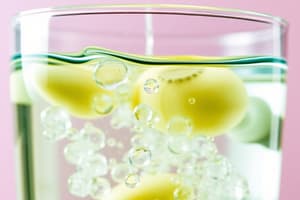Podcast
Questions and Answers
What percentage of body fluids is found in intracellular compartments?
What percentage of body fluids is found in intracellular compartments?
- 70% (correct)
- 50%
- 66%
- 60%
Which type of fluids constitutes 75% of the extracellular fluid compartment?
Which type of fluids constitutes 75% of the extracellular fluid compartment?
- Interstitial fluids (correct)
- Transcellular fluids
- Cerebrospinal fluids
- Intravascular fluids
Which component of blood is primarily responsible for the oncotic pressure that retains water in the circulatory system?
Which component of blood is primarily responsible for the oncotic pressure that retains water in the circulatory system?
- Water
- Nutrients
- Electrolytes
- Colloids (correct)
What is the normal range for hemoglobin concentration in the blood?
What is the normal range for hemoglobin concentration in the blood?
What hematological condition can cause the enlargement of the liver and spleen due to excessive blood cell production?
What hematological condition can cause the enlargement of the liver and spleen due to excessive blood cell production?
What is the main role of colloids in plasma?
What is the main role of colloids in plasma?
Which of the following types of fluids is primarily located in the spaces between tissues?
Which of the following types of fluids is primarily located in the spaces between tissues?
What percentage of red blood cell volume in blood is represented by hematocrit?
What percentage of red blood cell volume in blood is represented by hematocrit?
Which plasma protein is associated with clotting and is produced in the liver?
Which plasma protein is associated with clotting and is produced in the liver?
What is one potential adverse effect of epoietin alpha treatment?
What is one potential adverse effect of epoietin alpha treatment?
Flashcards are hidden until you start studying
Study Notes
Body Fluids and Electrolytes
- Body fluids comprise approximately 70% of total body weight; changes in fluid levels correlate with weight fluctuations.
- 1 liter of fluid equates to 1 kilogram of body weight.
- Body fluids are divided into two main compartments: intracellular (2/3) and extracellular (1/3).
Extracellular Compartments
- Extracellular fluid consists of:
- Interstitial fluids (75%)
- Intravascular fluids (25%) critical for homeostasis
- Transcellular fluids, which include fluid within cavities such as synovial fluid.
Blood Composition
- Blood is composed of plasma (60%) and formed elements including:
- Red blood cells (RBCs): 4-6 million cells per cubic millimeter (ccm)
- White blood cells (WBCs): 5,000-10,000 cells per ccm
- Platelets: 150,000-450,000 cells per ccm
- Hematocrit represents the proportion of blood volume that is composed of cells, typically around 40%.
Bone Marrow and Blood Cell Production
- Red marrow, found in flat bones, is responsible for producing RBCs (medullary hematopoiesis).
- Yellow marrow, located in long bones, serves as fat storage.
- In fetal development, liver and spleen produce blood cells (extra medullary hematopoiesis).
- Conditions such as leukemia may cause extramedullary hematopoiesis, leading to enlarged liver and spleen.
Red Blood Cell Metrics
- The concentration of RBCs influences hematocrit and hemoglobin levels:
- Normal hemoglobin levels: 12-18 grams per deciliter (g/dL)
- Hematocrit levels typically range from 36-54%.
Erythropoietin
- Epoietin alpha stimulates RBC production; however, excessive use can lead to hypertension due to increased blood viscosity.
Plasma Composition
- Plasma serves as a solvent for various substances:
- Solvent: Water
- Solutes:
- Colloids (plasma proteins) produced by the liver
- Acids and bases
- Nutrients and nitrogenous wastes
- Electrolytes
Colloids (Plasma Proteins)
- Colloids are large molecules that attract water, including:
- Albumin: 3.5-5.5 g/dL
- Globulin: 2.0-3.5 g/dL (alpha and beta globulins produced by the liver; gamma globulins produced by plasma cells)
- Clotting factors, such as Fibrinogen: 1.5-2.0 g/dL
- Lipoproteins, often referred to as cholesterol.
Body Fluids and Electrolytes
- Body fluids comprise approximately 70% of total body weight; changes in fluid levels correlate with weight fluctuations.
- 1 liter of fluid equates to 1 kilogram of body weight.
- Body fluids are divided into two main compartments: intracellular (2/3) and extracellular (1/3).
Extracellular Compartments
- Extracellular fluid consists of:
- Interstitial fluids (75%)
- Intravascular fluids (25%) critical for homeostasis
- Transcellular fluids, which include fluid within cavities such as synovial fluid.
Blood Composition
- Blood is composed of plasma (60%) and formed elements including:
- Red blood cells (RBCs): 4-6 million cells per cubic millimeter (ccm)
- White blood cells (WBCs): 5,000-10,000 cells per ccm
- Platelets: 150,000-450,000 cells per ccm
- Hematocrit represents the proportion of blood volume that is composed of cells, typically around 40%.
Bone Marrow and Blood Cell Production
- Red marrow, found in flat bones, is responsible for producing RBCs (medullary hematopoiesis).
- Yellow marrow, located in long bones, serves as fat storage.
- In fetal development, liver and spleen produce blood cells (extra medullary hematopoiesis).
- Conditions such as leukemia may cause extramedullary hematopoiesis, leading to enlarged liver and spleen.
Red Blood Cell Metrics
- The concentration of RBCs influences hematocrit and hemoglobin levels:
- Normal hemoglobin levels: 12-18 grams per deciliter (g/dL)
- Hematocrit levels typically range from 36-54%.
Erythropoietin
- Epoietin alpha stimulates RBC production; however, excessive use can lead to hypertension due to increased blood viscosity.
Plasma Composition
- Plasma serves as a solvent for various substances:
- Solvent: Water
- Solutes:
- Colloids (plasma proteins) produced by the liver
- Acids and bases
- Nutrients and nitrogenous wastes
- Electrolytes
Colloids (Plasma Proteins)
- Colloids are large molecules that attract water, including:
- Albumin: 3.5-5.5 g/dL
- Globulin: 2.0-3.5 g/dL (alpha and beta globulins produced by the liver; gamma globulins produced by plasma cells)
- Clotting factors, such as Fibrinogen: 1.5-2.0 g/dL
- Lipoproteins, often referred to as cholesterol.
Studying That Suits You
Use AI to generate personalized quizzes and flashcards to suit your learning preferences.




